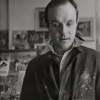Your shopping cart is empty!
Select currency
MENU

Keith Vaughan was born at Selsey, Sussex (1912) to Eric George Story Vaughan, a civil engineer, and his wife Gladys Regina Marian Mackintosh. After a few years the family moved to North London and here, interrupted only by his schooling at Christ’s Hospital, Hastings, Vaughan would live for the rest of his life. The headmaster of Christ’s Hospital was H. A Rigby, an authority on the artist Frank Branwyn whose murals adorned the school chapel, and Rigby encouraged Vaughan’s evident interest in the visual arts.
On leaving school Keith Vaughan was employed by Lintas, a Unilever advertising agency (1931-8). Privately he continued to paint, mainly with oils, and to study the works of the great masters, Cézanne, Matisse and Picasso in particular. At Lintas he made friends with the Australian artist John Passmore who rented a cottage in Suffolk. Here, for one year prior to the beginning of the war, Vaughan and Passmore would reside, painting, listening to music and visiting the ballet. What Vaughan saw in ballet was the groupings of people, and people in movement – aspects which would stay as preoccupations and evidence themselves in much of his later work.
Keith Vaughan was a conscientious objector. He joined the Pioneer Corps in 1941, and for most of the time worked as a clerk and German interpreter at the prisoner of war camp, Malton, Yorkshire. Here he found time to draw and to work in gouache, and here too he started to keep a journal which he continued throughout his life, and extracts from which, in the late sixties, he would publish (Journal and Drawings 1966). He enjoyed writing, and sent in short contributions to Penguin New Writing. He became friends with John Lehman, the founder of New Writing, and through his contributions he was invited to show drawings in a war art exhibition at the National Gallery. Here he met Graham Sutherland, John Minton and John Craxton – each of whom would influence Vaughan.
Keith Vaughan’s first exhibition of drawings was held at the Reid and Lefevre Gallery, London (1942) and here, in 1946, he also exhibited his paintings. In the subsequent decades he held one man shows in New York, Los Angeles, Buenos Aires and Sao Paulo, and in the UK he held a number of exhibitions, including at the Matthiesen Gallery (1960) and the Whitechapel Art Gallery (1962).
Keith Vaughan continued to paint when not working, but pursued teaching as a career: first at Camberwell (1946-8), then at the Central School of Arts and Crafts (1948-57) and from 1957 on as visiting teacher at the Slade School of Fine Art. He was also visiting resident artist at Iowa State University in 1959.
In subject matter Keith Vaughan increasingly concentrated solely on landscape and on a depiction of the male nude. His landscapes are influenced by Graham Sutherland’s work, whereas his portrayal of the male nude owes more to Cézanne’s late works depicting groups of people bathing. Over time, however, he departed from the more clearly figurative work of Cézanne, his figures become abstract, and his colours become patterns rather than portrayals of actual hues.
Keith Vaughan was elected honorary fellow of the Royal College of Art (1964) and in 1965 he was appointed CBE. For his working life he lived in Hampstead, London, but he travelled extensively to France, Spain, the USA, Mexico; to Greece and North Africa - the latter, particularly, having an important influence on his work.
Despite considerable success – including his award of CBE – towards the end of his life Keith Vaughan became increasingly melancholic and reclusive. He was diagnosed with cancer and took his own life in 1977. The last of Vaughan’s journals was published subsequent to his death (Drawing to a Close: the Final Journals of Keith Vaughan, Gerard Hastings, Editor) and as he lapsed into unconsciousness from his overdose his journal entry records: ‘It is a bright sunny morning. Full of life. Such a morning as many people have died on’.
Keith Vaughan’s works can be found in public collections worldwide, but also at the Tate, London, the Arts Council, London, the Fitzwilliam Cambridge.
This is a Limited Edition Giclee Print by the artist Keith Vaughan.350mm x 530mmEdition si..
£138.00 Ex Tax: £115.00
This is a Limited Edition Giclee Print by the artist Keith Vaughan.315mm x 380mmEdition si..
£138.00 Ex Tax: £115.00
This is a Limited Edition Giclee Print by the artist Keith Vaughan.295mm x 405mmEdition si..
£138.00 Ex Tax: £115.00